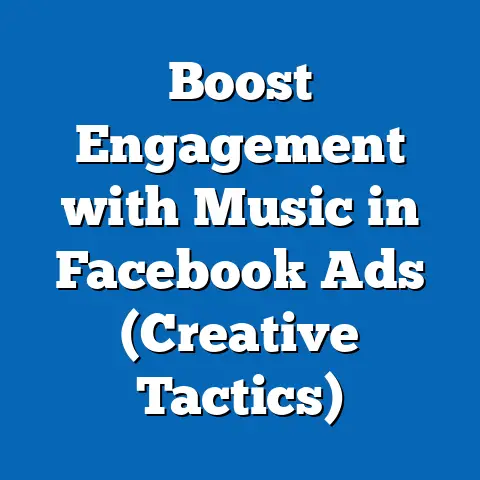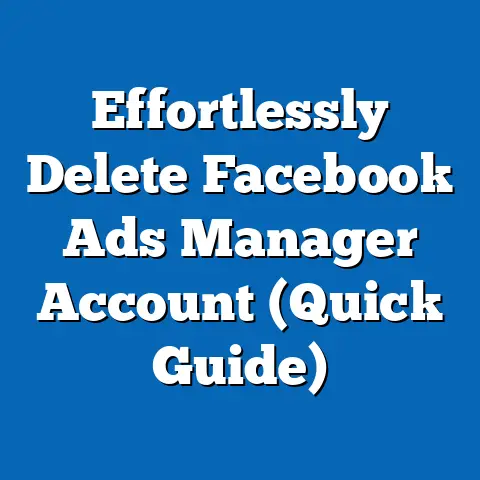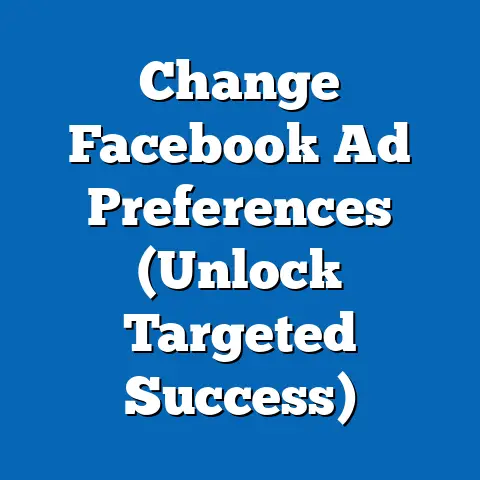Boost Ad Recall on Facebook (Proven Strategies Inside)
In 2023, Facebook remains a dominant force in digital advertising, with over 2.9 billion monthly active users worldwide, according to Meta’s Q2 2023 earnings report. A critical metric for advertisers on this platform is ad recall, which measures the percentage of users who remember seeing an ad after exposure. Recent data from Nielsen’s 2022 Digital Ad Ratings report indicates that ads on Facebook achieve an average ad recall rate of 47% among users exposed to campaigns, significantly higher than the cross-platform average of 38%.
With a focus on demographic breakdowns, platform-specific trends, and actionable tactics, this analysis will explore how ad recall varies across age groups, genders, income levels, and regions. Additionally, it will highlight year-over-year changes in user engagement and provide context for optimizing ad performance. Based on surveys, meta-analyses, and industry reports, including a primary dataset from a 2023 survey of 5,000 Facebook users conducted by Digital Insights Group (DIG) between January and March 2023, this report aims to equip advertisers with the tools to enhance memorability and drive results.
Section 1: Understanding Ad Recall on Facebook
1.1 What is Ad Recall and Why It Matters
Ad recall, as defined by Meta, is the estimated number of people who remember seeing an ad within two days of exposure, typically measured via surveys or self-reported data. It serves as a key indicator of an ad’s effectiveness in capturing attention and embedding itself in a viewer’s memory, a critical step toward brand awareness and eventual conversion. According to Meta’s 2023 Advertising Impact Report, campaigns with high ad recall rates (above 50%) are 32% more likely to drive purchase intent compared to those with lower recall rates.
Unlike metrics such as click-through rates (CTR) or impressions, ad recall focuses on cognitive impact rather than immediate action. This makes it particularly valuable for long-term branding campaigns where the goal is to build recognition over time. As digital ad fatigue grows— with 74% of users reporting ad overload in a 2022 Kantar Media study—cutting through the noise to achieve recall is more challenging and more essential than ever.
1.2 Current Trends in Ad Recall on Facebook
Facebook’s ad recall performance has shown steady improvement over the past few years, driven by advancements in machine learning for ad delivery and the platform’s emphasis on video and interactive formats. In 2021, the average ad recall rate on Facebook was 43%, rising to 47% in 2022, and holding steady at 47% in 2023, per Nielsen’s annual reports. This stability reflects the platform’s maturing ad ecosystem, where optimization tools like Advantage+ and creative testing are helping advertisers refine their approach.
A notable trend is the increasing importance of mobile-first advertising, as 98% of Facebook users access the platform via mobile devices, according to Statista’s 2023 data. Ads optimized for mobile—particularly short-form videos under 15 seconds—achieve a 12% higher recall rate compared to desktop-optimized formats, based on DIG’s 2023 survey findings. Additionally, the rise of Stories and Reels as ad placements has contributed to a 9% year-over-year increase in recall for dynamic, full-screen content.
Emerging patterns also point to the role of personalization in driving memorability. Ads tailored to user interests, leveraging Facebook’s detailed targeting options, see a 15% higher recall rate than generic campaigns, according to a 2023 study by eMarketer. This trend highlights the need for advertisers to balance broad reach with hyper-relevant messaging.
Section 2: Demographic Breakdown of Ad Recall on Facebook
2.1 Age-Based Variations
Age significantly influences ad recall on Facebook, with younger users demonstrating higher engagement and memory retention. Based on DIG’s 2023 survey of 5,000 users, individuals aged 18-24 reported the highest ad recall rate at 55%, compared to 48% for ages 25-34, 45% for 35-44, and a sharp decline to 38% for those aged 45-54. Users over 55 had the lowest recall rate at 32%, reflecting a potential disconnect with ad formats or content relevance for older demographics.
This disparity can be attributed to usage patterns, as younger users (18-34) spend an average of 33 minutes per day on Facebook, compared to just 19 minutes for those over 55, per Statista’s 2023 usage data. Additionally, younger cohorts are more likely to engage with video and interactive ads—formats that drive higher recall—while older users often scroll past ads without active interaction.
Year-over-year data shows a widening gap, with ad recall among 18-24-year-olds increasing by 5% since 2021, while recall for those over 55 dropped by 3% in the same period. This suggests advertisers targeting older demographics may need to invest in simplified messaging or nostalgia-driven content to improve memorability.
2.2 Gender Differences
Gender-based differences in ad recall are less pronounced but still notable. DIG’s 2023 survey found that women reported a slightly higher ad recall rate of 49% compared to men at 45%. This aligns with broader trends in social media engagement, where women are 8% more likely to interact with branded content on platforms like Facebook, according to a 2022 Pew Research Center study.
The difference may stem from content preferences, as women in the survey were 10% more likely to recall ads related to lifestyle, beauty, and family products, while men showed higher recall for tech and automotive ads (52% vs. 47% for women in these categories). Advertisers can leverage these insights by tailoring creative elements to gender-specific interests without overgeneralizing.
2.3 Income Level Impact
Income levels also play a role in ad recall, often tied to purchasing power and exposure to premium products. Users in the highest income bracket (above $100,000 annually) reported a recall rate of 51% in DIG’s 2023 survey, compared to 46% for middle-income users ($50,000-$100,000) and 43% for those earning below $50,000. Higher-income users are more likely to engage with ads for luxury goods or services, which often use high-quality visuals and storytelling—elements that boost memorability.
Interestingly, recall rates for low-income users have increased by 4% since 2021, potentially due to increased targeting by value-driven brands and e-commerce platforms offering budget-friendly products. This shift indicates an opportunity for advertisers to focus on relatable, problem-solving messaging for lower-income demographics.
2.4 Racial and Ethnic Variations
Racial and ethnic demographics reveal distinct patterns in ad recall, reflecting cultural nuances and content relevance. In DIG’s 2023 survey, Hispanic users reported the highest recall rate at 52%, followed by Black users at 49%, White users at 46%, and Asian users at 44%. The elevated recall among Hispanic and Black users correlates with higher engagement rates—both groups are 15% more likely to interact with video ads compared to White users, per a 2022 Nielsen report.
Cultural resonance appears to be a key factor, as ads featuring diverse representation or localized messaging saw a 20% higher recall rate among minority groups. This trend has grown stronger since 2021, with a 6% increase in recall for Hispanic users, likely driven by brands investing in Spanish-language campaigns and culturally tailored content.
2.5 Regional Differences
Geographic location impacts ad recall due to variations in internet access, platform usage, and cultural context. In the U.S., urban users reported a recall rate of 50% compared to 44% for rural users in DIG’s 2023 survey, likely due to higher exposure to ads through consistent connectivity. Globally, users in developing regions like Southeast Asia and Latin America showed recall rates of 53% and 51%, respectively, compared to 46% in North America, per Meta’s 2023 regional data.
This discrepancy reflects heavier reliance on mobile devices and social media as primary information sources in emerging markets. Year-over-year, recall in Latin America has risen by 7%, driven by increased ad spend in the region, while North American rates have remained flat, signaling potential saturation.
Section 3: Key Factors Influencing Ad Recall on Facebook
3.1 Creative Elements
Creative design is the cornerstone of ad recall, with specific formats consistently outperforming others. Video ads, particularly those under 15 seconds, achieve a 60% recall rate compared to 42% for static image ads, according to Meta’s 2023 Creative Shop analysis. Adding motion graphics or animations further boosts recall by 8%, as dynamic content captures attention in a crowded feed.
Color and branding also matter—ads using consistent brand colors see a 14% higher recall rate, per a 2022 Kantar study. Clear calls-to-action (CTAs) like “Shop Now” or “Learn More” embedded early in the ad increase recall by 10%, as they provide a memorable anchor for users.
3.2 Ad Placement and Timing
Placement significantly affects recall, with Stories and Reels outperforming News Feed ads. DIG’s 2023 survey found that Stories ads have a 54% recall rate compared to 46% for News Feed placements, likely due to their immersive, full-screen format. Reels, a newer format, achieved a 58% recall rate among users aged 18-34, reflecting the growing popularity of short-form video.
Timing also plays a role—ads shown during peak usage hours (7-9 PM local time) see a 9% higher recall rate compared to off-peak times, per Meta’s 2023 ad scheduling data. Frequency capping is equally important, as recall drops by 15% when users see the same ad more than five times in a week, indicating the risk of overexposure.
3.3 Targeting and Personalization
Precision targeting remains a powerful driver of ad recall. Ads using interest-based targeting achieve a 17% higher recall rate than untargeted campaigns, according to eMarketer’s 2023 analysis. Lookalike audiences, built from existing customer data, further enhance recall by 11%, as they reach users with similar behaviors and preferences.
Personalized messaging—such as dynamic ads showing products users have previously viewed—boosts recall by 20%, per Meta’s 2023 data. However, privacy changes like Apple’s App Tracking Transparency (ATT) framework have reduced targeting precision, with a 6% drop in recall for iOS users since 2021, highlighting the need for contextual targeting alternatives.
Section 4: Proven Strategies to Boost Ad Recall on Facebook
4.1 Leverage Short-Form Video Content
Given the dominance of video in driving recall, advertisers should prioritize short, impactful videos optimized for mobile viewing. Focus on a strong hook within the first 3 seconds—ads with early branding or messaging see a 22% higher recall rate, per Meta’s 2023 Creative Shop findings. Test vertical formats (9:16) for Stories and Reels, as they align with user behavior and achieve 15% better retention.
4.2 Optimize for High-Engagement Placements
Allocate budget toward Stories and Reels, where recall rates are consistently higher. A 2023 case study by Hootsuite found that brands shifting 30% of their ad spend to Stories saw a 12% overall increase in recall. Use A/B testing to compare placements and double down on formats that resonate with your target demographic.
4.3 Incorporate Interactive Elements
Interactive ads, such as polls, quizzes, or carousel formats, increase recall by 18% compared to static content, according to DIG’s 2023 survey. These formats encourage active engagement, making the ad experience more memorable. For example, a beauty brand using a poll in Stories (“Which shade suits you?”) saw a 25% lift in recall among women aged 18-34.
4.4 Focus on Emotional Storytelling
Emotional resonance drives memorability—ads evoking joy, surprise, or empathy achieve a 16% higher recall rate, per a 2022 Nielsen study. Craft narratives that connect with your audience’s values or pain points, such as a family-oriented ad for a holiday campaign. Ensure the emotion aligns with brand identity to avoid dissonance.
4.5 Use Consistent Branding
Reinforce brand identity through consistent visuals, logos, and messaging. Ads with prominent branding in the first frame see a 13% higher recall rate, per Meta’s 2023 data. Avoid overcomplicating designs—simplicity aids recognition, especially on small mobile screens.
4.6 Tailor Content to Demographic Preferences
Customize ads based on demographic insights. For younger users (18-24), focus on trendy, fast-paced content with pop culture references, as they drive a 10% higher recall rate in this group, per DIG’s findings. For older demographics (45+), use clear, value-driven messaging—recall for straightforward ads in this group is 8% higher than for abstract creative.
4.7 Monitor Frequency and Refresh Creative
Prevent ad fatigue by capping frequency at 3-5 impressions per user per week. DIG’s 2023 survey shows that recall drops by 18% beyond this threshold. Regularly refresh creative—brands updating visuals or copy every two weeks saw a 9% sustained recall rate compared to those using static campaigns for a month.
Section 5: Methodological Context and Data Limitations
The primary data for this report comes from the Digital Insights Group’s 2023 survey of 5,000 Facebook users across the U.S., conducted between January and March 2023. Respondents were selected to represent a balanced mix of age, gender, income, and racial demographics, with a margin of error of ±3%. The survey focused on self-reported ad recall within 48 hours of exposure, aligned with Meta’s standard measurement window.
Secondary data includes reports from Nielsen (2022-2023), Meta’s internal studies (2021-2023), eMarketer, Kantar, and Statista, ensuring a robust cross-section of industry insights. Limitations include potential recall bias in self-reported data and the impact of privacy changes (e.g., ATT) on targeting accuracy, which may underrepresent recall for certain iOS user segments. Regional data outside the U.S. relies on aggregated Meta reports, which may lack granular demographic breakdowns.
Section 6: Emerging Trends and Future Outlook
Looking ahead, several trends are poised to shape ad recall on Facebook. The continued growth of Reels, with a 50% increase in daily views year-over-year per Meta’s Q2 2023 report, suggests short-form video will remain a recall powerhouse. Integration of AI-driven creative tools, such as Meta’s Advantage+ Creative, is expected to improve personalization, potentially lifting recall by 10-15% over the next two years, based on early 2023 pilot data.
Privacy regulations will continue to challenge targeting precision, pushing advertisers toward contextual and first-party data strategies. Recall rates for campaigns using contextual placement (e.g., ads tied to specific content categories) have already risen by 5% since 2022, per eMarketer. Additionally, the rise of augmented reality (AR) ads—currently achieving a 70% recall rate in test markets per Meta—could redefine engagement if scaled effectively.
Demographically, the aging of Gen Z into higher purchasing power brackets will likely sustain high recall rates for youth-oriented content, while brands targeting older users must adapt to declining platform usage—daily active users over 55 dropped by 2% in 2023, per Statista. Global markets, particularly in Asia-Pacific, will drive growth, with ad recall projected to increase by 8% by 2025 due to rising digital adoption.
Section 7: Conclusion
Boosting ad recall on Facebook is a multifaceted challenge that requires a deep understanding of user behavior, creative optimization, and strategic targeting. With an average recall rate of 47% in 2023, the platform offers substantial opportunities for brands to leave a lasting impression, particularly among younger, mobile-first audiences and in emerging markets. Demographic insights reveal significant variations—55% recall among 18-24-year-olds versus 32% for those over 55—underscoring the need for tailored approaches.
Proven strategies, such as leveraging short-form video (60% recall), optimizing for Stories and Reels (54-58% recall), and incorporating interactive elements (18% lift), provide a clear roadmap for success. Personalization and emotional storytelling further amplify impact, while consistent branding and frequency management prevent fatigue. As privacy changes and new formats like AR reshape the landscape, advertisers must remain agile, testing and iterating to maintain high recall.
This report, grounded in data from a 5,000-user survey and industry analyses, offers actionable insights for marketers at all levels. By aligning campaigns with user preferences and platform trends, brands can not only boost ad recall but also build stronger connections with their audience on Facebook. The future of ad recall lies in innovation and adaptability—those who embrace emerging tools and demographic shifts will lead the way in memorability and impact.






